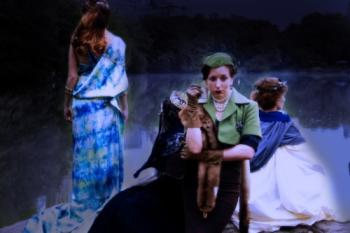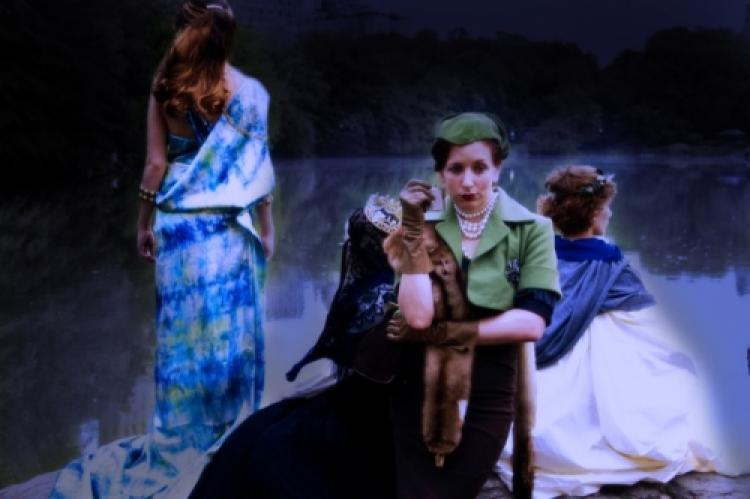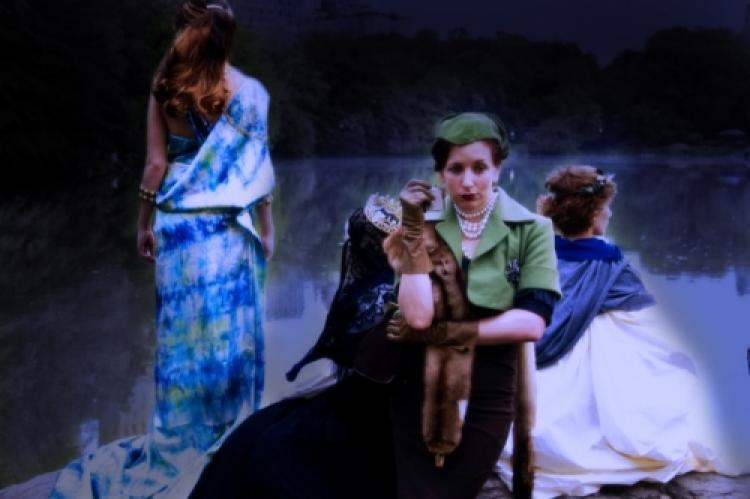A provocative sojourn
NEW YORK—In David Stallings’s “Anais Nin Goes to Hell” (Hell appears to be an island off the coast of Hades), Anais encounters five noted women who have apparently been stranded for centuries.
The lovely Grecian princess Andromeda (Marnie Schulenburg) and the 12th century nun Heloise (Aly Wirth) are joined by the imperious English Queen Victoria (Madalyn McKay), while fiery Joan of Arc (Colleen Piquette) frequently dashes about energetically brandishing her sword and sultry Cleopatra of Egypt (Maggie Benedict) lolls about nonchalantly. These diverse ladies all have the same need: They’re waiting for their men, with the exception of Joan, who is waiting for God Himself.
After 20th century erotic writer Anais Nin (Shelly Feldman) makes her appearance, she tries to endow the others with confidence and break the bonds of their futile waiting.
There’s an interesting mix of eras here. When Joan of Arc gets too hyper, Anais slips something into her mouth. She announces that it is lithium.
The style of the play is light and often zany, but nevertheless there’s plenty of opportunity for playwright Stallings to convey the stories of these celebrities. Of their prior relationships with men, Andromeda claims to be a virgin, while Heloise, now a nun, describes her sad tale of her passionate love for Abelard and how he was taken from her and robbed of his manhood.
Queen Victoria declaims about her great love for Prince Albert, and her sadness at his death. Cleopatra doesn’t comment much about her prior love life, which is odd, considering how much notoriety history has heaped upon her reputation. There is one amusing sequence, however, when one of the others comments that Cleopatra had been portrayed as a white woman—in fact, by a very famous white actress. Here, Cleopatra expresses amazement; she is, after all, clearly a woman of color, and actress Maggie Benedict supplies just the right note of tongue-in-cheek astonishment at this obvious error.
Anais Nin, the only participant in modern dress, appears to be the most sensible of the group. She’s been married twice and has had lovers too numerous to count. Why waste all this time waiting?
Arguably, the theatrical high point of the play is a Charleston danced and sung with great verve by Andromeda and Heloise, to the recorded backup of late pop star Karen Carpenter. The plaintiff lyrics include: “So long ago and oh so far away, I fell in love with you before the second show …”—another paean to fruitless waiting.
Toward the end of the play, a man does appear—well, sort of a man. He is Lord Alfred “Bosie” Douglas (Jeremy King), who had caused Oscar Wilde all that trouble—with “the love that dare not speak its name.”
Program notes indicate that the purpose of the producing company, MT Works (Maieutic Theatre Works), is “to birth new plays that question norms and boundaries about society, humanity and individuality.” I personally don’t see that this play fills that bill; however, the play’s content is certainly creative, with perhaps a nod to Caryl Churchill’s “Top Girls.”
The funny, deliberately simplistic sets, representing ocean waves (that sometimes move!) and a sturdy rock to sit on, are by Stephanie Tucci. Costumer designer David “DW” Withrow has obviously had a field day creating diverse styles, from the stern black gown of Queen Victoria to the revealing, iridescent outfit worn by Cleopatra.
Performance-wise, I vote for Shelly Feldman, Marnie Schulenburg, and Maggie Benedict. In charge of the hijinks is director Cristina Alicea.
Anais Nin Goes to Hell
New York International Fringe Festival 2008
Connelly Theater
220 East 4th St.
Tickets: (866) 468-7619 or www.fringenyc.org
Closes: Aug. 24
Diana Barth writes and publishes “New Millennium,” an arts newsletter. For information: [email protected]







